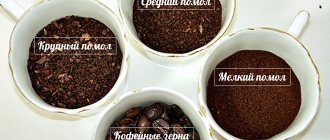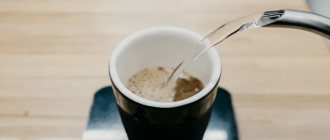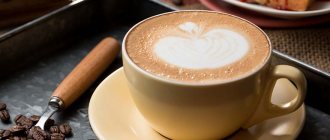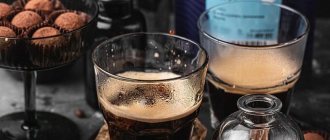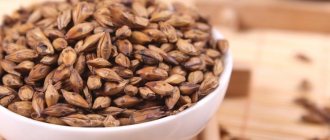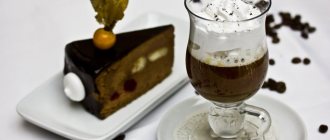Uniform roasting of coffee at home is possible if you use a frying pan, oven or a special device - a roaster. Unprocessed coffee beans have a weak aroma and unpleasant taste. You won't get a rich, invigorating drink from them. After processing, they acquire a brown color and a characteristic odor. Clean the grains, stir them constantly during roasting and be sure to keep an eye on the time.
Why fry?
Unroasted coffee beans are dense green beans that taste like peas. You cannot make a traditional invigorating drink from them. The taste and aroma of coffee that everyone is accustomed to is obtained after roasting. Under the influence of high temperature, grains change not only color, but also chemical composition. During the roasting process, the following changes occur to them:
- almost double in size;
- become lighter due to fluid loss;
- At first they turn yellow, then acquire a light brown or brown color; if overcooked, they turn black;
- tannins come out;
- caffeine is formed, which is responsible for the taste properties of the drink;
- Several hundred essential oils are released.
Advice from Poster
With the growing popularity of coffee shops, there are more and more bean roasters on the market. To decide who you want to cooperate with, first try the products that the company offers. Often roasters have shops or coffee shops where you can immediately brew coffee in different versions to evaluate its taste and aroma. Always taste coffee in your coffee shops and training centers with your team and conduct independent tastings.
Choose roasters that have a wide variety of beans. This way you can offer more different coffee flavors to your guests. And the main rule when choosing a roaster is stable grain every day.
Roasting degrees
There are many varieties of coffee beans. They have their own characteristics. But the taste and aroma also depend on the degree and method of frying. Coffee lovers believe that it is better to brew it from beans processed at home. After all, during industrial processing they lose most of their aromatic substances.
Those who roast their own coffee can choose the type and degree of roast to suit their taste.
- A light or light roast is achieved at temperatures up to 2000. This is the cinnamon or New England type. The taste is slightly sour.
- Medium roast is city or Viennese. Temperature 210-2300. The fruits acquire a brown color and a chocolate or caramel flavor.
- Dark roasting is achieved at temperatures up to 2450. The beans are a rich dark brown color. The taste is bitter and smoky. This is a French or Italian type. These beans are used for espresso.
- There is also maximum roasting or Spanish. The beans are fried at a temperature of 2500. They turn black-brown and acquire a sharp bitter taste. Not suitable for all varieties.
The effect of roasting on taste and aroma
The taste and aroma of the drink depend on the degree of roasting of the beans. This is discussed in the article “How coffee roasting levels affect taste and strength.”
When roasted at a medium level of 180-205 degrees, the coffee beans become light brown. They make a rich drink with bitter notes.
Heavily roasted grains change color to dark brown. For this you need 210-230 degrees. The drink acquires a nutty-chocolate taste.
You will get strong espresso with a pronounced bitterness if you prepare it from highly roasted beans at 240-250 degrees.
Methods for roasting coffee at home
It is not necessary to know how coffee is roasted on an industrial scale. Although the process itself differs only in quantity. But they use large special devices - roasters. They are also available for home use. It is easier to fry grains in such an apparatus, although this is also a responsible task: you need to monitor the process, choose the right quantity and temperature. After frying, the device must be cleaned.
But you can find out how gourmets roast coffee without a roaster. This can be done in several ways.
- In a frying pan - this is the most common method. A cast iron frying pan is best suited for this.
- In the oven, the roasting process seems simple, but it is also important to monitor the temperature and stir the beans.
- It is possible to roast coffee at home using a hairdryer. But for this you need to use its construction variety, which heats the air to 3000.
- Interested in learning how to roast coffee in the microwave. This method began to be used only in recent years, but quickly gained popularity.
How to roast coffee using a roaster
Currently, you can purchase various roasters that will help you roast coffee. The operating principle of these machines is similar to a device for making popcorn. A fast stream of hot air is used, which not only roasts the beans, but also keeps them moving.
This is one of the simplest methods of roasting coffee, with the roaster doing most of the dirty work.
- Place the required amount of beans into the roaster. You can determine the correct amount according to the instructions for the device.
- Close the roaster and turn it on.
- Let the coffee roast to the color you want. Don't forget: the longer the roasting process, the darker the beans will become and the stronger the flavor will be.
- Pour the coffee beans into a sieve and shake until the beans are warm, not hot.
- Store the resulting coffee beans at room temperature. At the same time, direct sunlight should not penetrate into the place of their storage.
Roasting coffee: step-by-step process
If you figure out how to roast coffee, you can make your own drink to suit your taste. The process itself is simple and has only a few steps.
- Prepare green grains for frying; to do this, rinse and sort them well.
- Before putting them in a frying pan or baking tray, dry them, then warm them up a little over low heat.
- Then fry at high temperature.
- Cool and remove husks.
- Pour the roasted coffee into a tin or ceramic jar.
In a frying pan
The easiest way to figure out how to roast coffee is in a cast iron skillet. This should be done on a gas or electric stove, but on a large burner.
- Wash and dry the grains before cooking.
- The frying pan needs to be heated to 220 degrees.
- Sprinkle the grains in a thin layer.
- The first few minutes will be smoky as the beans release liquid, so it is recommended to open the windows.
- Stir the grains constantly so that they heat evenly.
- When the coffee reaches the desired shade, pour it onto a cold baking sheet to cool.
Hairdryer
It is recommended to use this method when processing Robusta varieties. It is worth learning how to roast coffee with a hairdryer only for those who have such a device.
- You will need a shallow pan with a thick bottom.
- A colander is placed on it and beans are poured into it.
- Heat with a hairdryer over medium heat for 2-4 minutes, stirring constantly.
- Turn on the device at maximum power. Fry for 10 minutes.
- Turn off the appliance and stir the grains for about another minute to cool.
In the oven
It is best to use a clean baking tray; there should be no traces of food on it. How to roast coffee in the oven:
- Place the washed and dried beans in a thin layer;
- preheat the oven to 2400;
- place a baking tray;
- after 10-15 minutes a characteristic crackling sound will appear;
- the oven needs to be opened and the beans stirred for 3-5 minutes;
- Pour the finished grains into a colander to cool.
In the microwave
Some gourmets have figured out how to roast coffee in the microwave. This is the fastest and easiest way. A thin layer of dried grains is poured onto a glass plate. Then turn on maximum power. You need to fry for 3-4 minutes, periodically turning off the device and checking if the beans are burnt.
In the bread machine
This method is convenient because the process does not need to be constantly monitored. The grains are roasted evenly. You need to put the coffee in an oven preheated to 1200. Select a mode for 10-15 minutes. The top of the bucket needs to be covered with a net to prevent the husks from scattering.
How to Roast Coffee Beans in a Popcorn Maker That Uses Hot Air
A popcorn popper is an easy way to roast coffee. This method is recommended for all beginners who want to roast their own beans to try.
The whole process only takes a few minutes, but you can experiment with the degree of roasting. You can make it both light and dark. You can even create something in between. When starting to practice coffee making, you can't underestimate roasting your own beans in a machine that has only been half-used for years.
You will need:
- A popcorn maker that uses hot air.
- A bowl.
- Unroasted coffee beans.
- Thermometer (optional).
- Baking tray.
- Sealed container.
Preparation. Preheating
To get started, collect everything on the list above. Contact your local coffee retailer to purchase raw, unroasted green beans. You can buy different types. Ask how deep frying is required in each case.
At home, you should make room on the kitchen table. You need to place a popcorn maker, a bowl (for the husks) and a baking sheet in which the grains will later cool. Turn on the popcorn. It should take about 30 seconds for the device to preheat.
Pour in coffee beans
Once the popcorn maker has warmed up, you can pour half a mug of coffee beans into the container. It will take about 5 minutes to completely fry. You need to keep an eye on how the beans go through the different stages of roasting. Never leave the popcorn maker unattended.
Roast the coffee beans
During roasting, the beans go through several levels. You'll see them go from raw to ready for grinding and brewing coffee. You can decide for yourself what degree of roasting you want to achieve. It is important to be attentive to the process in order to learn to control the taste of the future drink, master the procedure to perfection and, most importantly, not let the grains burn.
Remove the grains and cool them
When you reach your desired roast level, turn off the popcorn maker and pour the coffee beans onto a baking sheet. This will allow them to cool down quickly. To speed up this process, you can lightly shake the pan. Allow the beans to cool completely before transferring them to a storage container.
Tips and tricks
Achieving perfect results when roasting coffee beans at home is difficult. To do this, you need to know the technology of this process, monitor the temperature and time. If you don't fry them thoroughly, the drink may turn out watery and tasteless. Overcooked grains will be very bitter and have a burnt taste.
To avoid mistakes, you can use the advice of experienced baristas.
- To roast coffee beans, you need to take dishes with a thick bottom. It warms up better.
- The mixing blades should be new, preferably wooden, so that they will not transfer the odors of other food to the grains.
- Do not pour out a large amount at once. For better frying you need to take about 150-200 g.
- The frying time depends on the flavor you want. In order for the drink to acquire the bitterness beloved by many, green coffee beans need to be heated for more than 10 minutes.
- We need to listen. When roasting, water evaporates from the beans, this process is accompanied by a characteristic crackling sound. The first crack appears when the sugar begins to caramelize. After this you should stop frying. If you stop after the second crack, you may end up with a burnt, bitter product.
- In order for the coffee beans to darken, they need to be simmered for longer than 10 minutes. The darker they are, the richer the drink will be.
- The smell will appear when the grains turn yellow. At first it will be unnoticeable, but will gradually intensify.
- To ensure that the beans roast evenly, they need to be stirred constantly.
- Some fans roast coffee along with spices. It is combined with cardamom, cinnamon, black pepper, ginger, and nutmeg. It is also recommended to add a little olive oil at the end of frying.
Ideally roasted beans will have a pleasant aroma, a uniform color without light spots or burnt areas. It should have a slight bitterness, without a burnt taste. They break easily with your hands and are also cooked in the middle. When good coffee is brewed, it quickly releases the aroma and flavor of the liquid.
Supplements
Spices improve the taste of the drink and give it a tart aftertaste. Used: ginger, nutmeg, cinnamon, cardamom. Find out more in the article “Spices and Seasonings for Coffee.”
The main thing is not to overdo it with additives. Add no more than a pinch of seasoning to 300 grams. Exceeding the norm will interrupt the taste and aroma of the drink.
It is better to grind the additive together with the grains. In this case, it will be possible to prepare a drink with a barely noticeable aftertaste.
To improve the taste of coffee berries, add 1 teaspoon of olive oil when cooking.
What to do next with grains
It is not enough to know how to roast coffee correctly; the quality of the drink depends on what is done with it next. After turning off the heat, you must immediately remove the coffee beans from the baking sheet or pan and cool. This is important because they will continue to heat up and may burn.
During industrial processing, they are cooled with a special fan or cold water. At home, you can simply pour the grains onto a cold metal surface in a thin layer. You should also try to remove the husks. To do this, they are poured into a colander or sieve.
Some grind and brew coffee immediately after roasting. And it turns out to be a tasteless drink. Roasted coffee beans should sit for at least 12 hours. During this time, carbon dioxide evaporates and chemical changes continue in the beans. Store roasted coffee in a clean, opaque jar or in a dark place.
There is not a single coffee lover who would not appreciate the benefits of the taste of a drink made from self-roasted beans. This is not difficult to do, if you take into account all the advice and recommendations of experts, you will get a truly tasty and aromatic product.
Subtleties and nuances
When roasting coffee, focus on sounds. It crackles because water is released and evaporated. At this moment the roasting begins.
Gradually the temperature increases, the grains dry out, and the sound becomes more intense.
The duration of the procedure affects the color of the grains. In 6-7 minutes they turn light brown. In 8-9 minutes they acquire a dark color.
The saturation of the drink depends on the color of the grains. Light ones have a mild taste, while dark ones have a bitter taste.
After 5-6 minutes of roasting, essential oils begin to release. They have a rich, persistent scent.
Interesting! How to grind coffee without a coffee grinder
Story
The first evidence of coffee roasting comes to us from the Ottoman Empire and dates back to the 15th century, when thin round plates of metal or porcelain were used as utensils. They were equipped with a long handle to make it convenient to hold the “pan” over a brazier with coals, periodically shaking and stirring the beans.
Around 1650, the cylindrical roaster was invented in Cairo for roasting large batches of coffee. Soon the innovation was adopted in France, Holland, Italy and other European countries.
Cylindrical roasters for roasting coffee beans
In the 19th century, many commercial roasters were patented for mass roasting of coffee. At the same time, lovers of this invigorating drink continued to fry beans by hand on baking sheets and stoves. For such enthusiasts, the home spherical list appeared in Ohio in 1849. However, since 1900, pre-roasted coffee has become much more profitable: thanks to advancing technology, it costs only slightly more than raw coffee.
In 1903 and 1906, electric roasters were patented in the USA and Germany, respectively, and the problem of smoking affecting the taste of the product was solved. In 1976, they learned to fry cereals with hot air without the risk of burning them in coals. Nowadays, there are many devices for roasting coffee, ranging from ordinary wire meshes that need to be placed on an open fire, to high-tech “smart” devices.
The boom of coffee shops in the 1970s made roasting beans at home almost meaningless, turning it into the preserve of gourmet connoisseurs: commercial roasters installed in coffee shops allow you to roast beans quickly and efficiently at any level, you can program the roasting style in them, while the barista does not have to pay attention to the stove and stir the coffee so that the beans do not burn.
Degrees of roasting of coffee beans
Coffee is usually purchased already roasted, or you can roast it at home. Now we will look in detail at how to do this at home and what effect temperature, coffee freshness and other conditions have on the yield of the finished product and the strength of the drink.
First degree light roast coffee
The first degree of roasting is called Scandinavian or cinnamon. Temperature 195 ° C Short heat, baking occurs over low heat. In a short time, the smell has time to develop, aromatic oils are released, and the grain increases slightly in size. Scandinavian wheat has a sour, yeasty or fresh bready smell.
The first degree of roasting is suitable for Kenyan and Jamaican highland coffee, as well as for Nicaraguan beans, which, due to their structure, produce water even at low temperatures.
The first type of roasted beans has a yellow-green color, and the coffee produced from them is weak, light brown in color, as if thick grounds are brewed. The smell and taste of this drink are subtle, sometimes the drink is slightly bitter. Roasted first-grade beans are prepared with water and milk (it is called women's coffee). The taste is very delicate and sour, the drink is weak and is used for weight loss.
Second degree medium done
The second stage is called American Roast or New England Roast. Temperature 205°C Roast the beans until they crackle or crackle. Coffee releases aromatic oils well. Due to the extraction of sugars from coffee starch, the bean begins to acquire a brown tint. Due to heating and loss of liquid, characteristic cracks appear on the grain.
The coffee smells good when roasting. The drink is darker than Scandinavian beans, the smell and taste are more distinct, but not fully revealed.
Third degree medium done
The third stage of light roast is called city roast and is cooked at 220 ° C. The beans are roasted between the first and second crackers. Cracks in the grain are clearly visible, and it takes on a patchy and uneven reddish-brown color. The drink turns out dark brown in color, the taste becomes distinctly coffee, herbal notes and slight sourness appear.
Medium roast beans are considered universal. Beans from Brazil, Colombia, Costa Rica and Ethiopia are subjected to this roasting. Medium roast is the most popular, as it is suitable for any method of preparing a coffee drink, Americano, cappuccino and other types.
First degree medium rare
The medium toasts start with the city or city. The beans are roasted at 225°C until the oil flows and a second crack appears. The beans have a natural sweetish taste and a rich dark color.
Brewed coffee has a rich dark color, a bitter-sour taste with natural sweetness, and nutty notes appear.
Second degree medium done
The second degree of medium roast has many names: Viennese, velvet, velvet, French light and business roast. The beans are roasted at 230°C until they are also dark brown in color and oil is clearly visible on the surface, causing the beans to smoke as they fry. The second clicks intensify the coffee aroma.
Viennese coffee has a bright taste and smell, is bitter and tones well, while it has a caramel sweetness and is not at all sour.
The second degree of roasting of coffee beans does not fully develop the taste and does not provide enough caffeine for energy. This coffee is good with cream and other additives.
First degree deep roast
A strong roast gives the coffee a dark brown, almost black color. The grains lose 20% of their weight due to loss of oil and water. The coffee caramelizes heavily, making the drink very strong and rich. Many Brazilian, Cuban and Guatemalan grains are deep fried.
The first degree of deep frying is called Turkish or French.
The grains are heated to a temperature of 240 ° C until setting completely stops. Burnt and bitter fried smell. The drink itself is bitter, but at the same time has a pronounced natural sweetness. The color is rich, matte. The drink is very strong.
Second degree deep roast
The second degree is called European, the names are continental and New Orleans. The coffee is kept at 250°C until it reaches the color of dark chocolate. There are many cracks on the surface of the grain, and thick smoke is generated during frying. If you put off frying, the beans will start to burn.
The strong roast goes well with sugar and alcohol; you can use these beans to make any coffee drink in any way.
European coffee is dense, almost black in color, with a dark, bitter and strong chocolate flavor. A good roast imparts a burnt caramel flavor. Used for expedition.
Highest degree
Top fries are called Cuban, Mexican or Spanish. With this method of heat treatment, the grains are brittle, almost black, and almost all the moisture has evaporated from them. The drink turns out very bitter and rich. During cooking, various seasonings are added to add a spicy taste. This roasting is used in Cuban, Guinean, and Ecuadorian coffee varieties. Drink with spices and sugar and serve in small portions.
Not only the method, but also the technology of roasting coffee beans is important. You can roast coffee yourself, or you can buy a ready-made version.
Coffee should be stored in an opaque container in a dark place so that it does not release a lot of carbon dioxide and does not oxidize in the sun. Coffee ready for roasting does not last long. Therefore, coffee lovers like to roast coffee beans in batches.
Cooling roasted coffee
In order for the desired degree of roasting to be recorded, the grain must be cooled quickly. To do this, you need to quickly pour it into a cold metal baking sheet in one layer. At the same time, the grains should not come into contact with each other.
After the coffee has cooled, it must be placed in a suitable container and left for 10-12 hours, during which the beans “reach”. After which the grains are poured into an opaque, airtight container for storage. It is recommended to grind coffee immediately before preparing the drink.
How to refrigerate and when to grind?
We've figured out how to roast coffee cherries, now let's talk about cooling. Let them cool immediately after baking. Maximum – in 1-2 minutes.
Roasted beans are hot and have a porous texture. If they do not cool, they will continue to cook on the grill and may burn. The drink will acquire a “cooked” aftertaste.
Transfer the prepared beans to a cold baking sheet and stir for 1-2 minutes. Then place them in a single layer so they don't touch each other.
When it's cold, place the baking sheet on a windowsill near an open window. The main thing is that it is not humid, there is no rain. Otherwise, the grains will become saturated with moisture and spoil.
You can also use two sieves and transfer the seeds from one to the other.
Roasted coffee beans should not be ground immediately after roasting. Heat treatment produces carbon dioxide. It must evaporate completely, otherwise the brewed drink will acquire a sour aftertaste.
Grind the beans half a day after baking.
Have you ever roasted coffee? Tell our readers how it went.
National Championships and Roaster of the Year Award
The best producers regularly improve the skills of their roasters; the most advanced ones participate in competitions and championships for prestigious awards. In Russia, the Coffee Roasting Championship is held annually for several years in a row. Moreover, competitions are held in two categories: among roasters and among companies.
In 2022, Roman Khomchenko, an employee of the Roasting Brew company, was recognized in the individual competition as the winner of the national award “Best Roaster”, established by the magazine “KiCh in Russia” and the Roschaykofe Association. Among the companies, Tasty Coffee Roasters was named the best; its representative Tikhon Anisenkov took third place, behind Artem Sukharev from the Coffee Laboratory.
At the National Qualifying Championship, which was held under the auspices of the SCA, Andrey Balashov from the Roasting Brew company was crowned with the laurels of the winner. Second place went to Sergey Simakov (Aleph), bronze went to Anton Volkov, representative of the Underground Coffee Project. At this stage of the competitive selection, 44 roasters, the best in their regions, measured their skills.
In March of this year, at the specialized site Russian Barista Days, as part of the Coffee Tea Cacao Russian Expo 1 exhibition, the results of the National Roaster of the Year award were summed up. The laurels of the winner were crowned by Alexey Stakanov from. “Silver” went to Stereo Coffee representative Grigory Feklistov, “bronze” went to Artem Sedov from Roasting Brew.

